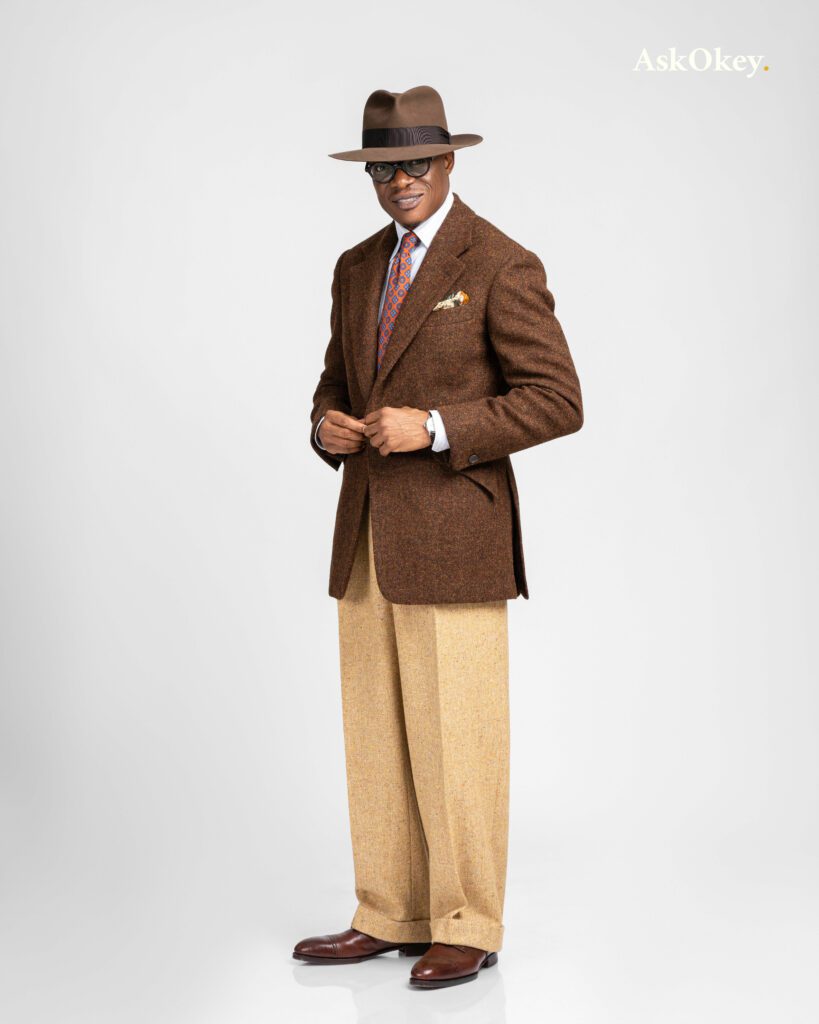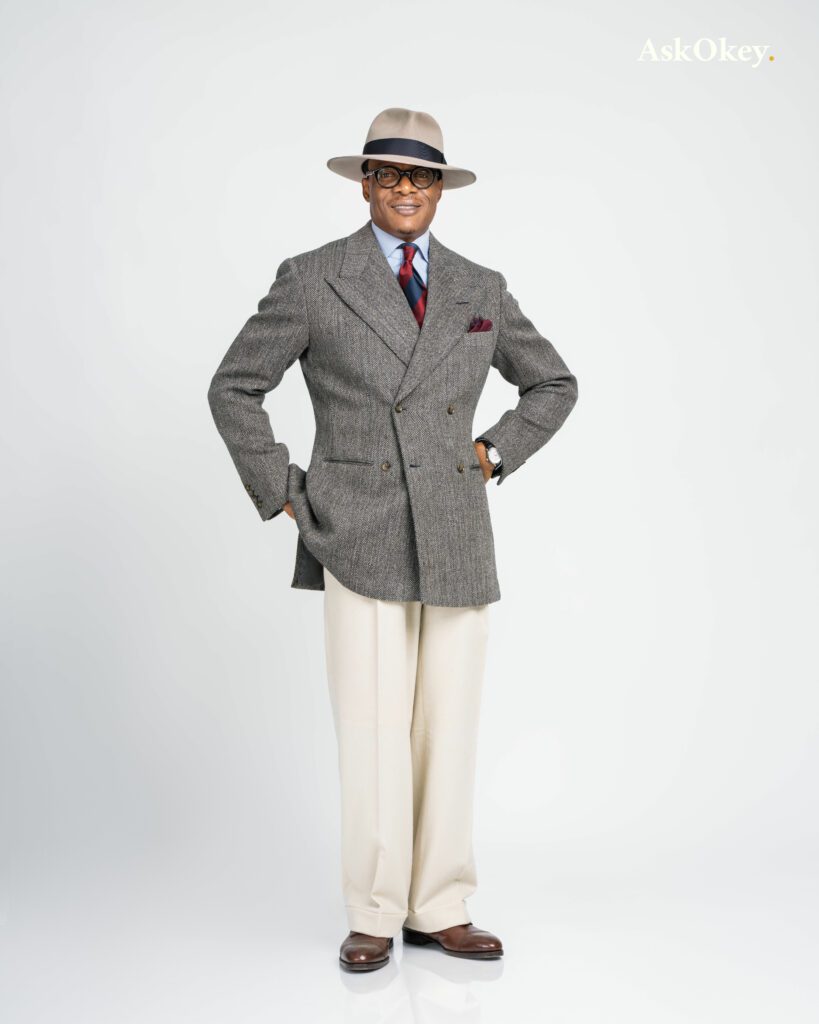AskOkey talks a great deal about its signature drape cut and why every man should insist on this mysterious feature when buying or ordering his jackets. So what is the drape cut, and why make a fuss about it?
The drape cut is quite simply a way of tailoring the chest, back and shoulders of a jacket so that it fits in a certain way. You can spot a jacket cut with a drape by the folds in the chest piece next to the shoulders, and in the back.
The purpose of the drape is to give the wearer more room or mobility, and to give him more of a shape (bigger chest and, correspondingly, a narrower waist). This is in contrast to the sack suit jacket or what is commonly referred to as the Italian suit jacket. There is nothing wrong with either. If well made, they will fit correctly and look elegant, but they do not generally provide the combination of comfort and elegance that the drape cut can give you.

The drape cut was pioneered by Frederick Sholte, a Dutch tailor working at Anderson and Shepherd in the 1920s. Rather than cutting jackets in the style then popular (a slim fit, close to the body), he developed a method where there was extra fabric (about an inch) in the chest on either side. The style was popularised by the Prince of Wales and other style icons of the time, and it became the standard for English tailors, at least, for the next couple of decades.
Also called the London cut, or the blade cut, the drape method made jackets look more casual and gave the wearer a distinctive “v” shape. The shoulders in the illustration below are probably more heavily padded than necessary, but you will get the idea.

Does a drape cut jacket look too big, or does it look too wide in the shoulders? If it is cut to your size, no. The extra folds and shoulder width that you see are not because the jacket is “too big”, but because we are accustomed to seeing jackets that are actually too small (where they need to be bigger). Of course, if your jacket really is too big for you in the shoulders or chest, it will show, drape cut or not.
In terms of jacket construction, the drape cut needs a full canvas and it works better with heavier fabrics, which can be shaped and stretched better than lighter weights. At the time, most suits and jackets were made of what would today be called heavy cloth (light weight was 13 oz, so winter suits and jackets were usually well above 16 oz). The reasons are as follows: houses and offices did not have central heating, and cloth weaving technology did not allow for making the yarns that you need for light weights. Check out vintage jackets from before the 1950s and you will notice how sturdy and, in many cases, rough the fabric is. The armhole is high, the sleeves have extra fabric and the waist is narrow.

Why do you need a drape cut jacket? The drape cut is particularly helpful if you are thin, extra tall, extra short, wider in the waist than in the shoulders or less than athletic in terms of your build. Thus, the drape cut makes you look better and can give even the most pear shaped among us the illusion, at least, of a ‘V’ shape.
Is the drape cut “old fashioned”? 40 years ago, it would have been (Armani gave us faux drape for a few years in the late 80s, in a deliberate nostalgia-driven campaign), but today, not necessarily. Keep in mind that drape is a tailoring method, not a style, so you can still have your narrow lapels, high button stance and shorter jacket, if you want to. Check out Sean Connery’s drape cut suits from the 60s for a modern take on a venerable design. And don’t forget, Sean Connery did not have to take off his jacket to fight villains. A testimony to the utility of the drape cut.
Who makes the drape cut today? Anderson and Sheppard, Huntsman and other Savile Row tailors who made it famous still use a version of the drape cut but in a milder way than they used to. Very few give you the genuine article largely because their cutters and tailors have forgotten how to do it, today’s menswear trends do not demand it and today’s lightweight fabrics will not take the shaping and handwork required. So beware tailors claiming to provide it. Ask to see examples, feel them and, if possible, try one on and look for the folds, move around in it and check how the lapels sit at the front.
The drape cut is never found in ready-to-wear nowadays. It was – pick up an English or American RTW suit from the 1950s and you will notice immediately that the maker has given you extra chest space, the lapels do not pull at the front and the jacket is comfortable (if it is your size) – but today’s RTW, normally made with fusing rather than a canvas, does not have those features.
All that said, what’s next? Consider a drape cut for your next bespoke purchase. If your tailor really does not know how to do it, contact us at AskOkey.com.
Hello,
I came across your work just recently on YouTube and almost watched every short there is, I really admire it and your style as well.
I’m someone that lives in a suit but always felt not comfortable with the fit, have tried everything as much as my financial situation allows.
I got two bespoke suits last year in Turkey since since workmanship is far less expensive there and I’m Turkish but still am not sure on the fit, even thought of learning tailoring myself so I can make my own suit myself hahaha.
I see this as a big chance and as I see the fit on Mr Okey and the quality of it I literally got excited and thought that at last I found my future suit.
I’m excitedly waiting for your response.
Kind regards
Besbopke takımı nerde yaptırdınız?
Hello Burak, Nasulsun.
Our products are available on our website http://www.askokey.com/shop
You can place your order today for your bespoke suit. Please send us an email at [email protected] and our team would be delighted to assist you further.
Teshekular
I recently discovered the mention of the drape cut of a man’s jacket in novels written by Amanda Quick which take place in the 1920s. Being the curious creature I am I had to do some exploring on Google and found this article. I’ve always liked this style and now I know what it is called. Thank you for the information!
Brilliant find Mary, thank you for your comment.